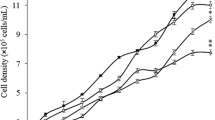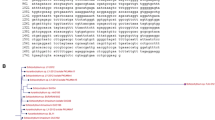Abstract
Astaxanthin is a kind of ketone carotenoid belonging to tetraterpenoids with an excellent antioxidant activity and it is widely used in nutrition and health-care industries. This study aimed to explore the effect of different abiotic stresses on carotenoid production in Schizochytrium sp. Firstly, the characteristics of carotenoid accumulation were studied in Schizochytrium sp. by monitoring the change of carotenoid yields and gene expressions. Then, different abiotic stresses were systematically studied to regulate the carotenoid accumulation. Results showed that low temperature could advance the astaxanthin accumulation, while ferric ion could stimulate the conversion from carotene to astaxanthin. The glucose and monosodium glutamate ratio of 100:5 was helpful for the accumulation of β-carotene. In addition, micro-oxygen supply conditions could increase the yield of β-carotene and astaxanthin by 25.47% and 14.92%, respectively. This study provided the potential regulation strategies for carotenoid production which might be used in different carotenoid-producing strains.






Similar content being viewed by others
References
Mao X, Liu Z, Sun J, Lee SY (2017) Metabolic engineering for the microbial production of marine bioactive compounds. Biotechnol Adv 35:1004–1021
Lee C, Choi Y-E, Yun Y-S (2016) A strategy for promoting astaxanthin accumulation in Haematococcus pluvialis by 1-aminocyclopropane-1-carboxylic acid application. J Biotechnol 236:120–127
Tran NT, Kaldenhoff R (2020) Metabolic engineering of ketocarotenoids biosynthetic pathway in Chlamydomonas reinhardtii strain CC-4102. Sci Rep 10(1):10688
Fang N, Wang C, Liu X, Zhao X, Liu Y, Liu X, Du Y, Zhang Z, Zhang H (2019) De novo synthesis of astaxanthin: from organisms to genes. Trends Food Sci Technol 92:162–171
Astaxanthin market size by source, by application, industry outlook report, regional analysis, application potential, Covid-19 impact analysis, price trends, competitive market share & forecast, 2021–2027. Global Market Insights, Inc. https://www.gminsights.com/industry-analysis/astaxanthin-market. Accessed 24 Feb 2022
Zhou P, Li M, Shen B, Yao Z, Bian Q, Ye L, Yu H (2019) Directed coevolution of β-carotene ketolase and hydroxylase and its application in temperature-regulated biosynthesis of astaxanthin. J Agric Food Chem 67:1072–1080
Sheng B, Fan F, Huang J, Bai W, Wang J, Li S, Li W, Wan M, Li Y (2018) Investigation on models for light distribution of Haematococcus pluvialis during astaxanthin accumulation stage with an application case. Algal Res 33:182–189
Christian D, Zhang J, Sawdon AJ, Peng C-A (2018) Enhanced astaxanthin accumulation in Haematococcus pluvialis using high carbon dioxide concentration and light illumination. Biores Technol 256:548–551
Chen J-h, Wei D, Lim P-E (2020) Enhanced coproduction of astaxanthin and lipids by the green microalga Chromochloris zofingiensis: Selected phytohormones as positive stimulators. Biores Technol 295:122242
Geng L, Chen S, Sun X, Hu X, Ji X, Huang H, Ren L (2019) Fermentation performance and metabolomic analysis of an engineered high-yield PUFA-producing strain of Schizochytrium sp. Bioprocess Biosyst Eng 42:71–81
Ren L-J, Sun X-M, Ji X-J, Chen S-L, Guo D-S, Huang H (2017) Enhancement of docosahexaenoic acid synthesis by manipulation of antioxidant capacity and prevention of oxidative damage in Schizochytrium sp. Biores Technol 223:141–148
Chatdumrong W, Yongmanitchai W, Limtong S, Worawattanamateekul W (2007) Optimization of docosahexaenoic acid (DHA) production and improvement of astaxanthin content in a mutant Schizochytrium limacinum isolated from mangrove forest in Thailand. Nat Sci 41:324–334
Jiang YL, Zhu Q, Liao YN, Wang QQ, Li Y, Dong XY, Peng J, Yuan JP, Wang JH (2020) The delta 5,7-sterols and astaxanthin in the marine microheterotroph Schizochytrium sp. S31. J Am Oil Chem Soc 97:839–850
Zhang K, Chen L, Liu J, Gao F, He R, Chen W, Guo W, Chen S, Li D (2017) Effects of butanol on high value product production in Schizochytrium limacinum B4D1. Enzyme Microb Technol 102:9–15
Du H, Liao X, Gao Z, Li Y, Lei Y, Chen W, Chen L, Fan X, Zhang K, Chen S (2019) Effects of methanol on carotenoids as well as biomass and fatty acid biosynthesis in Schizochytrium limacinum B4D1. Appl Environ Microbiol 85:e01243-e11219
Zhao Y, Wang H-P, Han B, Yu X (2019) Coupling of abiotic stresses and phytohormones for the production of lipids and high-value by-products by microalgae: A review. Biores Technol 274:549–556
Watanabe K, Arafiles KHV, Higashi R, Okamura Y, Tajima T, Matsumura Y, Nakashimada Y, Matsuyama K, Aki T (2018) Isolation of high carotenoid-producing Aurantiochytrium sp. mutants and improvement of astaxanthin productivity using metabolic information. J Oleo Sci 67:571–578
Zhao Y, Yue C, Ding W, Li T, Xu J-W, Zhao P, Ma H, Yu X (2018) Butylated hydroxytoluene induces astaxanthin and lipid production in Haematococcus pluvialis under high-light and nitrogen-deficiency conditions. Biores Technol 266:315–321
Ren LJ, Huang H, Xiao AH, Lian M, Jin LJ, Ji XJ (2009) Enhanced docosahexaenoic acid production by reinforcing acetyl-CoA and NADPH supply in Schizochytrium sp. HX-308. Bioprocess Biosyst Eng 32:837–843
Ren LJ, Feng Y, Li J, Qu L, Huang H (2013) Impact of phosphate concentration on docosahexaenoic acid production and related enzyme activities in fermentation of Schizochytrium sp. Bioprocess Biosyst Eng 36:1177–1183
Ren LJ, Hu XC, Zhao XY, Chen SL, Wu Y, Li D, Yu YD, Geng LJ, Ji XJ, Huang H (2017) Transcriptomic analysis of the regulation of lipid fraction migration and fatty acid biosynthesis in Schizochytrium sp. Sci Rep 7(1):3562
Ren LJ, Sun GN, Ji XJ, Hu XC, Huang H (2014) Compositional shift in lipid fractions during lipid accumulation and turnover in Schizochytrium sp. Biores Technol 157:107–113
Park H, Kwak M, Seo J, Ju J, Heo S, Park S, Hong W (2018) Enhanced production of carotenoids using a Thraustochytrid microalgal strain containing high levels of docosahexaenoic acid-rich oil. Bioprocess Biosyst Eng 41:1355–1370
Li G, Zhou YG, Ji F, Liu Y, Adhikari B, Tian L, Ma ZH, Dong RJ (2013) Yield and characteristics of pyrolysis products obtained from Schizochytrium limacinum under different temperature regimes. Energies 6:3339–3352
Hu XC, Tang XY, Bi ZQ, Zhao QY, Ren LJ (2021) Adaptive evolution of microalgae Schizochytrium sp. under high temperature for efficient production of docosahexaeonic acid. Algal Res-Biomass Biofuels Bioprod 54:102212
Kozlova TA, Hardy BP, Krishna P, Levin DB (2017) Effect of phytohormones on growth and accumulation of pigments and fatty acids in the microalgae Scenedesmus quadricauda. Algal Res-Biomass Biofuels Bioprod 27:325–334
Zhou PP, Ye LD, Xie WP, Lv XM, Yu HW (2015) Highly efficient biosynthesis of astaxanthin in Saccharomyces cerevisiae by integration and tuning of algal crtZ and bkt. Appl Microbiol Biotechnol 99:8419–8428
Nanou K, Roukas T (2013) Oxidative Stress response of Blakeslea trispora induced by iron ions during carotene production in shake flask culture. Appl Biochem Biotechnol 169:2281–2289
Saha SK, Moane S, Murray P (2013) Effect of macro- and micro-nutrient limitation on superoxide dismutase activities and carotenoid levels in microalga Dunaliella salina CCAP 19/18. Biores Technol 147:23–28
Smirnova EG, Lyubimov YI, Malinina TG, Lyubimova EY, Alexandrushkina NI, Vanyushin BF, Kolesova GM, Yaguzhinsky LS (2002) Ionol (BHT) produces superoxide anion. Biochemistry-Moscow 67:1271–1275
Roukas T (2016) The role of oxidative stress on carotene production by Blakeslea trispora in submerged fermentation. Crit Rev Biotechnol 36:424–433
Braunwald T, Schwemmlein L, Graeff-Hönninger S, French WT, Hernandez R, Holmes WE, Claupein W (2013) Effect of different C/N ratios on carotenoid and lipid production by Rhodotorula glutinis. Appl Microbiol Biotechnol 97:6581–6588
Funding
This work was supported by the National Key R&D Program of China (No. 2019YFA0905700), the National Natural Science Foundation of China (No. 21878151), and the Natural Science Foundation of Jiangsu Province (BK20211535).
Author information
Authors and Affiliations
Contributions
LL: investigation, formal analysis, writing—original draft. XT: methodology, conceptualization. YL: methodology, formal analysis. XH: conceptualization, data curation, software. LR: supervision, funding acquisition, writing—review and editing.
Corresponding author
Ethics declarations
Conflict of interest
The authors declare that they have no known competing financial interests or personal relationships that could have appeared to influence the work reported in this paper.
Ethical approval
This article does not contain any studies with human participants or animals performed by any of the authors.
Additional information
Publisher's Note
Springer Nature remains neutral with regard to jurisdictional claims in published maps and institutional affiliations.
Supplementary Information
Below is the link to the electronic supplementary material.
Rights and permissions
About this article
Cite this article
Li, L., Tang, X., Luo, Y. et al. Accumulation and conversion of β-carotene and astaxanthin induced by abiotic stresses in Schizochytrium sp.. Bioprocess Biosyst Eng 45, 911–920 (2022). https://doi.org/10.1007/s00449-022-02709-9
Received:
Accepted:
Published:
Issue Date:
DOI: https://doi.org/10.1007/s00449-022-02709-9




